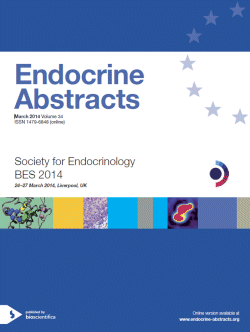Searchable abstracts of presentations at key conferences in endocrinology
Symposia
MEN1 ‐ from molecular pathology to therapies (Supported by <emphasis role="italic">Endocrine-Related Cancer</emphasis>)
ea0034s9.1 | MEN1 ‐ from molecular pathology to therapies (Supported by <emphasis role="italic">Endocrine-Related Cancer</emphasis>) | SFEBES2014
Current understanding and future perspectives in MEN1: the molecular pathology of the MEN1 gene and menin
The MEN1 gene is located on chromosome 11q13; it spans 9 kb, has ten exons, and encodes a 610 amino acid protein named menin (isoform-2, NCBI Reference Sequence: NP_570711.1). Germline heterozygous inactivating mutations in this gene are observed in 70% of patients with the multiple endocrine neoplasia type 1 (MEN1) syndrome who develop multiple tumours in various endocrine (parathyroid, pancreas, and pituitary) and non-endocrine tissues with loss of the remaining nor...
ea0034s9.2 | MEN1 ‐ from molecular pathology to therapies (Supported by <emphasis role="italic">Endocrine-Related Cancer</emphasis>) | SFEBES2014
Genetics, pathophysiology and translational models of MEN1
Multiple endocrine neoplasia type 1 (MEN1) is an autosomal dominant disorder characterised by the occurrence of parathyroid, pancreatic islet, and anterior pituitary tumours. In addition, some patients may also develop adrenal cortical tumours, carcinoid, facial angiofibromas, collagenomas, and lipomatous tumours. The gene causing MEN1 is located on chromosome 11q13, and encodes a 610 amino-acid protein, menin, that represents a tumour suppressor, as its loss of expression is ...




